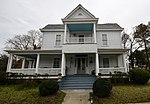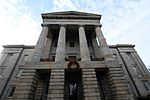Cameron Village Historic District
Historic districts on the National Register of Historic Places in North CarolinaModernist architecture in North CarolinaNRHP infobox with nocatNational Register of Historic Places in Raleigh, North CarolinaNeighborhoods in Raleigh, North Carolina ... and 2 more
Raleigh, North Carolina Registered Historic Place stubsUse mdy dates from August 2023

Cameron Village Historic District in Raleigh, North Carolina is a national historic district listed in 2011 on the National Register of Historic Places. The district encompasses 93 contributing buildings and 1 contributing object and was developed between about 1950 and 1955. It is considered North Carolina's first planned mixed-use development.Nearby Village District Shopping Center is not included in the Historic District.
Excerpt from the Wikipedia article Cameron Village Historic District (License: CC BY-SA 3.0, Authors, Images).Cameron Village Historic District
Smedes Place, Raleigh Oberlin
Geographical coordinates (GPS) Address Nearby Places Show on map
Geographical coordinates (GPS)
| Latitude | Longitude |
|---|---|
| N 35.793888888889 ° | E -78.6575 ° |
Address
Smedes Place 701
27605 Raleigh, Oberlin
North Carolina, United States
Open on Google Maps











